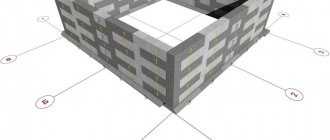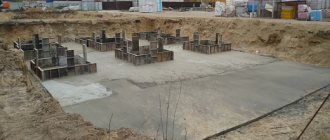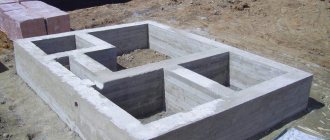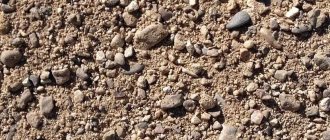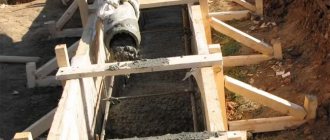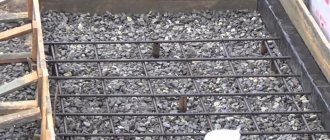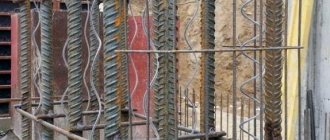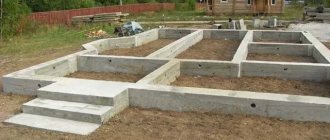The need for accurate calculations
The photo shows large-scale concreting in industrial construction
Why is it so important to correctly know the volume of the required solution, because if there is not enough material, more can be made? In fact, maximum strength and durability of monolithic structures is ensured only if the solution is supplied to the formwork for concrete products without long downtimes. You can avoid downtime that can lead to delamination of concrete by knowing the exact amount of mixture that will be required for certain construction work
You can avoid downtime that can lead to delamination of concrete by knowing the exact amount of mixture that will be required for certain construction work.
Current calculation formulas
In the photo - an installation for preparing mortars in limited quantities
At the moment, there are many ways to carry out calculations, for example, you can use a concrete volume calculator. But an online calculator may not be available at the most crucial moment, and therefore we will consider those formulas that can be implemented in practice at any time and under any circumstances.
It is no secret that there are several types of foundations laid to varying depths before the start of the main construction work. Depending on the configuration of these structures, their size and, as a result, the volume of solution that is required varies.
Formula for columnar bases
In the photo - formwork for a columnar (pile) foundation
So, how to calculate the volume of concrete? To do this, you need to measure the height of the structure, find out the area and multiply these indicators. But the approach to calculations in accordance with the formula V=S*H is relevant only for simple structures, while a different approach will be required to calculate the volume in relation to complex structures.
The calculation method for columnar foundations with round piles is as follows:
- We calculate the area of the base of each pillar, we do this using the formula S = 3.14*r², where r is the radius of each individual pile;
- Next, we multiply the area parameters by the estimated height of the pile and get the volume;
- Then we multiply the resulting volume by the number of piles that will be used according to the project.
Calculations for slab-type foundations
In the photo - slab base formwork
Now let's look at how to calculate the volume in m3 of concrete for a slab foundation.
The instructions in this case are simple, since such a base is a solid structure.
- First, we divide the planned perimeter of the foundation into rectangles. This must be done if the shape of the base is complex. If the configuration is simple and is a rectangle or square, we find out the area by multiplying the length by the width.
- Next, we determine the depth of the bookmark and multiply this number by the resulting area.
Calculation of the volume of material for a strip foundation
In the photo - strip base formwork
A strip concrete foundation is by far the most popular type of foundation, as it is characterized by sufficient strength and durability. In addition, by choosing this type of base, you can save mortar, since it will not be poured along the entire perimeter of the object, but only under load-bearing walls and partitions.
Calculating the volume of concrete in this case is not complicated and is performed as follows:
- We measure the expected width and total length of the tape. We multiply the resulting parameters and obtain the area of the base.
- Then we determine how deep the foundation will be, and multiply this number by the area and get the nominal volume of mortar that is necessary for pouring into the formwork.
Calculating the cubic capacity of concrete to level the floor
It is important to understand exactly how to calculate how much concrete is needed for the floor. If you incorrectly determine the tonnage of the solution, prepare it less, and then you will need to buy more ingredients. It is better to avoid such situations, because a high-quality screed must be poured in one go. Therefore, we will study all the features of the calculations in order to avoid mistakes.
We multiply the following quantities:
- floor area. Multiply the width by the length;
- screed thickness. Everything is simple here;
- consumption coefficient 1.02.
For example, S of the floor is 30 m2, the thickness of the screed is 0.05 m. To carry out the work, we will need 1.53 m3 of cement mortar. Things are more complicated when there are differences in the base. Then the height of the concrete layer is determined by the lowest point (the largest number is taken).
We need to know the volume in order to select the components that need to be purchased. So be guided by the following:
- The construction documentation indicates that to prepare one cubic meter of cement composition, 490 kg of binder is required. Leveling the floor is allowed using a dry compound of a grade not lower than M400. Moreover, the higher the grade, the more sand you can add;
- By multiplying the cubic capacity and the original unit - 490, we will get a figure that explains how much binder to buy. It is better to make a purchase with a small reserve, but not too significant, because the remains of the dry composition are difficult to store; if moisture gets into the packaging, the cement hardens and becomes unsuitable for further use;
- There is sand in the leveling solution. It is used with Portland cement in a ratio of 3:1. That is, if we take one bucket of binder, we should take 3 buckets of sand. Thus, we multiply the above derived indicator by 3, we obtain the required volume fraction.
Important!
There is water in the cement mortar. But we do not take it into account. It does not affect the cubic capacity of the finished composition, because it fills the voids formed between grains of the binder composition and grains of sand. Process water cannot be used for preparation, as it will reduce the strength of the finished mixture. The water must be clean, without foreign impurities.
Tiled foundation type. Quantity of reinforcement and binding wire.
The amount of reinforcement depends on the soil and the weight of the building. Let's say your structure stands on stable ground and is light in weight, then thin reinforcement with a diameter of 1 centimeter will do. Well, if the structure of the house is heavy and stands on unstable ground, then thicker reinforcement from 14 mm will suit you. The pitch of the reinforcement frame is at least 20 centimeters.
For example, the foundation of a private building is 8 meters long and 5 meters wide. With a step frequency of 30 centimeters, 27 rods are needed in length and 17 in width. 2 belts are needed, so the number of rods is (30+27)*2=114. Now let's multiply this number by the length of one rod.
Then we will make a connection at the places of the upper reinforcement mesh with the lower mesh, and we will do the same at the intersection of the longitudinal and transverse bars. The number of connections will be 27*17= 459.
With a slab thickness of 20 centimeters and a distance of the frame from the surface of 5 cm, this means that for one connection you need a reinforcement rod with a length of 20 cm-10 cm = 10 cm, and now the total number of connections is 459 * 0.1 m = 45.9 meters of reinforcement.
Based on the number of intersections of horizontal rods, you can calculate the amount of wire required. There will be 459 connections at the lower level and the same number at the upper level, for a total of 918 connections. To tie one such place, you need a wire that is bent in half, the entire length for one connection is 30 cm, which means 918 m * 0.3 m = 275.4 meters.
Monolithic slab base
Determining the volume of materials on a slab base
A monolithic base is a large rectangular slab immersed to a specific depth in the soil.
This means that calculating the volume of the slab will take a minimum of time, because using ready-made drawings of load-bearing walls you can calculate the length, width and thickness of the structure.
For example: the length of the foundation is 12 meters, width 7 meters, thickness 0.6 meters. As a result, the volume of the slab will be as follows: 12*7*0.6=50.4 m3.
But this volume does not entirely correspond to reality, because any monolithic slab has a reinforcing mesh. You can also calculate the total volume of all the rods and trim and subtract it from the total volume of the foundation.
Calculation for slab base
Material calculation table for slab foundations.
This type of foundation is the most convenient for performing calculations. It is made in the form of a rectangular monolithic parallelepiped. To determine the volume of a parallelepiped, it is enough to first multiply the length by the width to find out the area, and then multiply the resulting value by its height.
For example, there is a monolithic slab measuring 9x12 m and 35 cm thick. First, 9 m of width must be multiplied by 12 m of the length of the slab. The result will be 108 m² of the base area of the future slab. Then the area of the sole should be multiplied by the height of the slab: 108 m² multiplied by 0.35 m will result in a total of 37.8 m³. Accordingly, to pour such a slab you will need 38 cubic meters of ready-made concrete.
If the slab is made with additional stiffeners, then their volumes should be added to the result obtained. Most often there are 4 of them, one on each side of the slab. First you need to find out the volume of one rib, and then multiply the result by their number.
In the example given, the slab may have two stiffening ribs 9 m long and two 12 m long. Their width and height are usually made the same, for example, a width of 30 cm and a height of 25 cm. Therefore, the volume of a 9-meter rib will be: 9x0.3x0.25 =0.675 m³. Two such ribs will be 0.675x2 = 1.35 m³.
The volume of a 12-meter rib will be 12x0.3x0.25=0.9 m³. The volume of two ribs is 0.9x2=1.8 m³. The total volume of such a slab will be 37.8 + 1.35 + 1.8 = 40.95 m³.
Foundation calculation
If you take a responsible approach to calculating the volume of consumables, then there is a chance to reduce your current costs and make construction less expensive at all levels. Moreover, there are simplified calculation options available to citizens who have never encountered construction engineering.
The homeowner is able to independently make all the necessary calculations that affect the final amounts that will be used for the purchase of building materials and for carrying out work. Cost calculation allows you to correctly place emphasis in the construction process and build a reliable home ownership.
Formwork
To assemble the formwork, panel materials are used (OSB sheets, plywood or boards at least 5 cm thick). It is designed with an indentation upwards of several centimeters from the level of the poured concrete and consists of an outer and inner deck.
This step is not always required. Instead of formwork, it is possible to use polystyrene foam or other insulating material and use reinforced concrete blocks.
Construction costing is a stage that will save not only money, but also time!
The calculator's interface is easy to understand, and to perform calculations you only need to specify the parameters of your foundation.
Calculation of materials for wall construction
The price of construction is largely determined by the cost of the materials used, and that is why it is so important to know in advance how much of something will be used to construct the walls. As a rule, walls are not cast entirely from concrete, but a monolithic frame is made in the form of columns in the corners and horizontal crossbars
Wall blocks, bricks or other masonry materials are placed in the cavity of the frame
As a rule, walls are not cast entirely from concrete, but a monolithic frame is made in the form of columns at the corners and horizontal crossbars. Wall blocks, bricks or other masonry materials are placed in the cavity of the frame.
In order to calculate the volume of the frame, you need to draw a diagram of the structure as a whole and break it down into individual columns and crossbars. Now we have to calculate the volume for each individual element, which will be much easier. To do this, calculate the cross-sectional area of the columns and crossbars and multiply them by the height.
Tape
The most popular foundation for the construction of a private house is considered to be a strip foundation. It is a kind of closed ribbon of concrete running under all the load-bearing walls of the building.
How to calculate how many cubes of concrete are needed for the foundation? Calculators that help determine the consumption of cement-sand mortar for pouring are available on many construction-related websites, one of which is presented at the end of this material. To calculate the volume in cubic meters, you need to know the linear dimensions of the structure: height, width and total length of the base.
Concreting of the strip base occurs by pouring the finished cement-sand mixture into wooden formwork with pre-installed reinforcing mesh. Large fractions (gravel, crushed stone) are added to the solution to obtain higher strength characteristics of the foundation.
The dimensions of the base depend on the dimensions of the building that is planned to be erected. Typically, the width of the foundation strip is at least 300 mm, the height of the ground part is from 400 mm, and the depth can reach 1500-2500 mm, depending on the availability of groundwater, freezing depth and the desire to equip a basement. It is not recommended to install strip foundations on heaving soils if the formwork is buried below the freezing depth.
The length of the foundation will be equal to the total length of all external walls, including the internal load-bearing wall, under which the foundation is also installed. As a result, having received all the required values, you can calculate the volume of concrete for the foundation. In this case, a calculator may not be required - just multiply all the indicators in meters and get the desired number in cubic meters.
The calculation formula looks like this:
V=h*b*l, where:
- V – volume of solution in m3;
- h – height in m;
- b – width in m;
- l – tape length in m.
For example, for a building measuring 6x6 m and one internal load-bearing wall, with a foundation height of 2 m and a width of 0.4 m, the volume of mortar for pouring will be: V = 2 * 0.4 * 30 = 24 m3. With the same width and height of the foundation, for a house measuring 10x10 and two load-bearing internal walls, the calculation will look like this: V=2*0.4*60=48 m3.
This calculation allows you to calculate the almost exact cubic capacity of the solution, but it should be remembered that during transportation some of the concrete is lost, and also if the formwork is loose, part of the concrete solution may leak out, but at the same time there is an additional internal volume occupied by the reinforcement frame. Therefore, it would be correct to introduce a correction factor in the direction of increasing the calculated value by 2%.
As a result, we obtain a more accurate formula for calculating the volume of concrete for a strip foundation:
V=h*b*l + 0.02*(h*b*l)
The resulting value is rounded to the nearest whole number. For our examples, the refined calculation will look like this: for a house 6x6 V=24+0.02*24=24.48 (25) m3, for a house 10x10 V=48+0.02*48=48.96 (49) m3 .
Consumption of components per 1 cubic meter of solution
Table of consumption of bulk components for concrete mortar
Having calculated the volume of the foundation in m³, you also need to determine the required number of mixture components. It depends on the preferred brand of concrete and the type of cement used. To equip the foundation, concrete must have a digital value of at least 100. To prepare a mixture marked 200 from M400 type cement, you will need to mix it with sand and crushed stone in a ratio of 1: 2.8: 4.8. If you need concrete of grade 300 or 400, there will not be such a pronounced dominance of the last two components. To produce mortar grade 400 from M400 cement, the ratio C:P:SH will be 1:1.2:2.7, for M500 it will be 1:1.6:3.2.
To calculate how many cubic meters of concrete will be needed to pour the base, you need to find the volume of the planned structure. To take into account possible losses of raw materials, a correction factor of 1.02 is used.
Pile-grillage and screw foundation
Diagram of a piled concrete foundation
The total cubic capacity of such foundations is the summation of the volumes of the pillars and slabs of the grillage.
In other words, this is a combined version of calculating a strip foundation and a columnar one.
Only here the cubic capacity of the pillar cylinder is taken into account in the calculation.
Attention, if factory bored piles or screw metal structures are used, then only the tape part of the grillage is calculated, and the parameters of the pillars are not used. They can only be used when calculating the required amount of excavation work
They can only be used when calculating the required amount of excavation work.
Help for inexperienced developers: online concrete calculator
To calculate the cubic capacity of the foundation, you can use Internet services offered by manufacturers of concrete mixtures. The tool presents a form with the necessary columns for the assessment. After filling out the table, the result is provided automatically within a few seconds.
The advantages of the method include multifactoriality. Depending on its algorithm, the program can take into account not only geometric parameters, but also the presence of reinforcement, strength class, and the price of ordering the finished mixture. Using such a calculator, you can not only solve the problem of ordering the required amount of mortar, but also check your own calculations to determine the capacity of formworks with complex configurations.
Determining the volume of a strip foundation
In general, you can calculate the amount of concrete for pouring a strip base yourself. To do this, you need to know the height, width and length of the tape. If the foundation has the same width and height along its entire length, then you can use a simple geometric formula:
V = S*L.
In this formula, the letter “S” denotes the cross-sectional area of the foundation, which can be calculated by multiplying the width of the foundation by its height. The letter "L" indicates the total length of the concrete strip.
For example, you can consider the following option:
The strip base for a house measuring 10*8 meters has a width of 0.4 meters and a height of 0.8 meters. First, the cross-sectional area of the foundation is determined:
Concrete for pouring strip foundations
S = 0.4*0.8= 0.32 m2.
Next, calculate the total length of the concrete strip, which is equal to the perimeter of the house:
L = (10+8)*2 = 36 meters.
Now you can safely calculate the volume of a strip base with the same cross-section along its entire length:
V = 0.32*36 = 11.52 m3.
Consequently, to pour a strip foundation for a house measuring 10*8, about 12 cubic meters of concrete solution are needed.
If the foundation has different widths in individual sections, then the calculation is carried out separately for each section, then the resulting values are summed up.
It is also important to take into account those parts of the foundation that are located under all load-bearing partitions, calculate their volume and add to the overall result
How do you make your own calculations?
Calculate the volume of the strip foundation.
For calculations, you need to know the dimensions of the foundation.
If for some reason you cannot use the described online service, you will have to carry out all the calculations on your own.
The cubic capacity of the slab base.
This foundation is the simplest option for calculations. To produce them, it will be enough to multiply the length of the slab by its width and thickness.
- For example, these parameters are 10, 10 and 0.4 meters.
- Therefore, the volume of concrete required: 10 × 10 × 0.4 = 40 cubic meters.
- Note! However, often, in order to increase the strength of the foundation, its slab is equipped with stiffeners. If the foundation design is exactly like this, to calculate the amount of material needed, you need to separately calculate the volume of the ribs and slab, then add up the results.
We already know the figure regarding the slab. Let's calculate the cubic capacity of the reinforcing elements.
- Let our foundation have four of them. Suppose the length of the edge is 10 m, height 0.25 m, width 0.3 m. This means the volume of one element is: 10 × 0.25 × 0.3 = 0.75 cubic meters.
- Total value for all ribs: 0.75×4= 3 cubic meters.
- Now we just have to add the numbers to get the amount of mortar needed for the foundation: 40+3=43 cubic meters.
Calculate the volume of the foundation calculator.
Computer calculation program.
Initially, it is necessary to determine the cross-section of such a foundation. When it is equal, everything is simple. It is necessary to multiply the perimeter of this structure by its width and thickness. Below are calculation instructions.
Let's take as an example the same structure with sides of 10x10 meters. Let the width of the base be 0.4 m and the thickness 0.7 m.
- Its perimeter is: 10×4=40 meters.
- We multiply the values and get 40 × 0.4 × 0.7 = 11.2 cubic meters. But this is only the volume of the base for the external walls.
Note! The cross-section of the foundation strip for external walls and partitions, as a rule, is not the same. The walls are much lighter and thinner, so there is no need to build sections of the base for them that have the same width as for the outer walls.
- Let the house have two partitions, one 10 m long, and one perpendicular to it - 5 m. Their width will be 0.3 m, the thickness will be the same - 0.7 m.
- Cubic capacity of the first section: 10×0.3×0.7= 2.1.
- Parameters of the second wall: 5×0.3×0.7=1.05.
- We add up all the values and get the final volume of concrete required for the strip base: 11.2 + 2.1 + 1.05 = 14.35 cubic meters.
Tile foundation.
A slab foundation is a monolithic structure poured under the entire area of the building. To make the calculation, you need basic data, that is, area and thickness. Our building measures 5 by 8 and its area will be 40 m2. The recommended minimum thickness is 10-15 centimeters, which means when pouring the foundation we need 400 m 3 of concrete.
The height of the main slab is equal to the height and width of the stiffener. This means that if the height of the main slab is 10 cm, then the depth and width of the stiffener will also be 10 cm, it follows that the cross section of a 10 cm rib will be 0.1 m * 0.1 = 0.01 meters, then multiply the result by 0.01 m, for the entire length of the rib 47 m, we obtain a volume of 0.41 m 3.
Strip foundation
In plan, this type of base structure is a strip contour of a rectangular or more complex shape with internal sections for partitions. To calculate the volume of concrete for a rectangular foundation, you need to subtract the volume of the parallelepiped along the inner contour from the volume of the parallelepiped with dimensions along the outer contour. The result will be the volume of the foundation tape itself. The internal partition parts can be divided into sections of the same cross-section to calculate each section separately. To determine the total volume, the volumes of all such sections are summed up.
Example 1.
Plan of a strip foundation for an example of calculating concrete cubic capacity.
- The volume along the external contour will be equal to 10 x 8 x 2.4 = 192 m³
- The volume along the internal contour is 143.63 m³.
- The volume of the external part along the perimeter will be 192 – 143.63 = 48.4 m³
- The volume of the internal part (8.8 + 6.2) x 0.6 x 2.4 = 17.72 m³ is the product of the cross-sectional area and the total length in m.
- In total, 66.13 m³ of concrete will be needed for pouring
Calculations in this case were made according to the drawings. When determining the volume of concrete in the installed formwork, you should take actual measurements of the formwork and similarly make the necessary calculations.
Types of concrete structures.
How to calculate the volume of concrete for a foundation.
The foundation is the basis of any structure. Based on this, it is necessary to ensure that it is sufficiently reliable and durable.
From the very beginning you need to decide on the type of foundation. It depends:
- on the massiveness and area of the building;
- building materials from which it will be built;
- type of soil on the site;
- climatic conditions;
- soil freezing level;
- availability of groundwater.
Only after this can you calculate the volume of the foundation yourself. At the moment, there are three most common types of concrete foundations: strip (monolithic). slab, as well as from concrete pillars.
Note! During computational work, all necessary parameters should be carefully measured. Even a small inaccuracy can have a very sad effect on the outcome of your efforts.
Calculation of the foundation for a private home
Let's figure out how to calculate the cubic capacity of a foundation - a concrete structure with a minimum thickness. The formula used is:
V = A×B×C, where the final value is volume, and the rest are length, width and height. Thus, obtaining the cubic capacity of this type of foundation is simple and quick, you just need to know the initial data.
This foundation structure is considered the most durable and stable, because there are no joints on it that somewhat violate the integrity.
For example, a building has an area of 10 × 10 meters and the structure will use 20 supports with a square cross-section. The location of the pillars will be as follows:
- 4 in the corners,
- 16 on the remaining area around the perimeter of the facility.
The concrete pillar has a cross-section of 300 × 300 mm and a height of 2 meters, the base has a cross-section of 500 × 500 mm and a thickness of 20 centimeters. The cubic capacity of the base of the concrete pillars is 20 × 0.5 × 0.5 × 0.2 = 1. And the volume of the supports: 20 × 0.3 × 0.3 × 2 = 3.6. And if you add up the calculation results, it turns out that 4.6 cubic meters of foundation are required for this construction project. For round posts the formula is used:
V = π × r2 × h, where the height of the support and its diameter are involved. When the volume of one pillar with a circular cross-section is determined, you need to multiply by the number of supports.
How to calculate materials for a columnar foundation
When building a columnar foundation, it is necessary to correctly calculate the foundation for the house.
The online calculator processes the following data::
- number of support columns;
- diameter and height of piles;
- dimensions of the expanded part of the support located in the ground;
- grillage dimensions;
- grillage structure configuration;
- brand of concrete mixture used.
Using available information about the design features and dimensions of the pile foundation, calculations can be made manually. To do this, you need to determine the volume of one support and multiply the resulting value by the total number of piles. The volume of the grillage is calculated similarly to the tape base. By adding the volume of the supports with the volume of the grillage, we obtain the total volume of the pile structure. Now calculating the amount of concrete is not difficult.
Strip foundation made of blocks or stones
Ready trench for strip foundation
The calculation of a strip structure resembles a monolithic one, only there are a number of features. To begin with, there is always less concrete mortar used here, because the strip base has load-bearing side and intermediate edges, and the inner surface is empty. So, what quantities are needed to accurately calculate the strip structure:
- The length of all load-bearing walls and intermediate load-bearing partitions;
- The width of the foundation pit, taking into account the thickness of the walls and the allowance for formwork;
- Foundation depth;
- Type of base: monolithic concrete or prefabricated with blocks, natural or artificial rubble stone.
Thus, a typical calculation of a strip structure with overall dimensions of 10x12 meters, a strip width of 0.4 meters and a depth of 2 meters, as well as one longitudinal strip for an interior partition with a thickness of 0.5 meters, can be calculated in the following way:
- Solid parallelepiped taking into account voids: 10 x 12 x 2 = 240 m3.
- Empty sections inside the structure: (10-0.4-0.4)*(12-0.4-0.4)*2 = 206.08 m3.
- The difference in volumes that will go to all external and internal walls is: 240-206.08 = 33.92 m3. You immediately need to round this value to a larger whole number, because there is also the thickness of the space for the formwork.
- Interior tape (10-0.4-0.4)*0.5*2 = 9.2 m3.
- Total. The total cubic capacity of the strip foundation with the given parameters is 33.92 + 9.2 = 43.12 m3 (44.0 m3).
What to pay attention to when laying a foundation
In some cases, the cost of installing a foundation reaches a third of the cost of the entire construction, so the desire of some developers to save money results in dire consequences. There are also errors due to the inexperience and carelessness of performers. Let us briefly list what should not be allowed when laying the foundation:
1. Inconsistency of the foundation structure with the type of soil at the building site. Strip foundations, in particular, are installed on stable, dry soils. On waterlogged soils, pile or slab structures are preferred. If there is no design solution, specialists should recommend the type of foundation.
Wall cracks due to foundation settlement
2. Incorrect arrangement of the sole under the strip foundation. Often the sole is arranged carelessly, because unscrupulous builders do not consider it necessary to carefully carry out work, the results of which are difficult to control. As a result, the distribution of the load on the sole turns out to be uneven, the foundation “creeps” - cracks appear in it, and then in the constructed building.
3. Incorrect installation of formwork and, as a result, insufficient outer layer of concrete to guarantee the closure of the reinforcement cage, corrosion of the reinforcement. Unreliable fastening of the formwork.
4. Lack of calculation of the concrete cube. This calculation needs to be done when pouring yourself. Since the components of concrete have different properties, a cube of concrete should be calculated in order to accurately determine the volume of materials for constructing the foundation.
5. Inaccurate adherence to the geometry of the structure. Uneven corners in rooms are not the biggest nuisance, which can be a consequence of irregularities in shape. The consequence of such an error may be, for example, a lack of slab length for the floor installation.
6. The lack of reinforcement or “savings” on diameters and quantities threatens that the foundation will not withstand the load.
7. Incorrect bandaging (or lack thereof) of foundation blocks when constructing prefabricated types of foundations.
What is the composition of the concrete mixture and how to calculate it
Before calculating a cube of concrete for pouring the foundation, you need to decide what grade of concrete is needed. So, knowing the cubic capacity, you can easily calculate how many kg of cement, sand or crushed stone you need. When making concrete, cement grade M400 is used. It is suitable for the foundation for the construction of a house made of timber. There is a table of values for obtaining different grades of concrete:
| Brand | Components per cube of concrete, kg or l | |||
| Cement | Crushed stone | Liquid | Sand | |
| M 75 | 170 | 1053 | 210 | 945 |
| M 100 | 210 | 1080 | 210 | 870 |
| M 150 | 235 | 1080 | 210 | 855 |
| M 200 | 286 | 1080 | 210 | 795 |
| M 250 | 332 | 1080 | 215 | 750 |
| M 300 | 382 | 1080 | 220 | 705 |
But materials are usually delivered by car, then it will be easier to make the calculation in parts:
- M 75 – 1 cement +6 crushed stone + 5.4 sand +1.2 water.
- M 100 – 1 cement + 5 crushed stone + 4 sand + 1 water.
- M 150 – 1 cement + 4.6 crushed stone + 3.6 sand + 0.9 water.
- M 200 – 1 cement + 3.8 crushed stone + 2.8 sand + 0.7 water.
- M 250 - 1 cement + 3.3 crushed stone + 2.3 sand + 0.65 water.
- M 300 – 1 cement + 2.8 crushed stone + 1.9 sand + 0.6 water.
For the convenience of readers, we provide a formula that will help you calculate the ratio of concrete components for the foundation of a wooden house yourself:
Cement 10%+ Crushed stone 45%+ Sand 25%+ Water 15%+ Air 5% = concrete mixture
The construction of any house begins with the calculation of the foundation; it is the support for the entire overlying structure, and the durability of the entire structure depends on how well it is installed. When deciding to carry out the work of creating a foundation with your own hands, it is important to avoid mistakes in the initial calculations, and even more so, there is no need to try to save on materials. Remember that a well-designed foundation is the key to your safety .
Instructions
The average user does not have to be a construction specialist to use our service. The interface is intuitive, and the program will indicate any invalid value with red highlighting.
In most cases, you only need to enter a minimum amount of information:
- estimated dimensions of the foundation;
- brand of fittings to choose from;
- brand of concrete.
In the process of calculating the foundation for a house, you may need to enter some additional values, but they can also be calculated on our calculators:
We have prepared an introductory video for you, which explains step by step all the functionality and operating principle of the online foundation calculator.
Our calculator also allows you to calculate the volume (cubic capacity) of the foundation in m3 , so that you know in advance how much excavation work needs to be done.
Calculation of concrete for the foundation
Concrete is the most important component of the foundation; in fact, it is its “flesh” and most of the characteristics of the foundation depend on how high-quality the mixture is used. When choosing a solution, special attention should be paid to the strength class (grade) , which determines the maximum permissible compressive loads of the fully formed mixture. Expressed in kgf/cm², i.e. how many kg can 1 cm 2 of surface support?
For the most part, the grade of concrete is determined by the proportions of cement, sand (crushed stone, gravel) and water, as well as the conditions under which the solution hardened. In total, there are about 15 strength classes from TM50 (B3.5) to M800 (B60), but in private construction the most The most common brands are M100-M400. Accordingly, M100 concrete is suitable for light structures - garages, bathhouses, equipment, and M400 - for multi-story heavy buildings, for example, made of brick. But in the vast majority of cases, M300 grade concrete is chosen.
Using our calculator, you will receive a calculation of concrete for the foundation (volume, mass). All values will be available directly in the interface - you do not need to switch to other tabs. However, you are required to enter the grade of concrete used.
Types of foundations
Engineers accept the foundation structurally using detailed calculation formulas. What is taken into account when choosing:
- House weight;
- Temporary loads;
- Soil type;
- Ground water level.
Having compared a number of factors and calculation results, experts accept one of the types of foundations:
- Tape;
- Pile;
- Slab;
- Columnar (only for light houses);
- Combined (complex design, which can only be accepted as a result of professional calculations).
The most common type of base is tape. This design can be adopted for a house with any parameters for all types of soils, except for floating ones. To calculate such a foundation, you need to know the height and width of its wall to the base (it is part of the foundation), as well as the perimeter of the house and the length of all internal walls.
It is advisable to choose bored piles for private housing construction - they are practically not inferior to ready-made factory products, but installing them is much easier and cheaper. The design of the pile foundation also includes a strapping grillage, which must be taken into account when calculating the concrete.
The slab is a solution for construction on floating soils. This is a kind of cushion that is able to maneuver on the base during seasonal liquefaction of the soil and during periods of its instability.
Formula for calculations
The required amount of concrete must correspond to the formwork parameters. Therefore, in order to calculate the cubic capacity of concrete for driving the foundation, it is necessary to know the geometric dimensions of the form. Armed with a tape measure, we measure the already set form and rely on the necessary parameters:
- width;
- height;
- length.
As many years of construction practice show, relying on ready-made formwork in calculations, you can get more accurate calculations than being guided by dry numbers of working drawings. In addition, by taking repeated measurements, you can identify errors in the installation of the foundation mold and eliminate them in a timely manner.
In the case of simple figures, the calculation formula is as follows:
When performing calculations, the values should be brought into a unified calculation system - cm, m. For concrete, the parameter most often used is m 3, less often liters. When converting units of measurement between values, the following proportion is used: 1 m 3 of concrete = 1000 liters. In this case, the density of the composition does not affect the quantitative indicators. The mixture, compacted, for example, by vibration, in its cubic capacity corresponds to the displacement, like concreting materials made using conventional technologies.
In the case of constructing a foundation of a complex configuration, the object is conditionally divided into simple figures - parallelepipeds or other simple elements (circles, cylinders, etc.). Calculations are made for each element separately, and the resulting values are summed up.
How to order concrete correctly
Correctly calculating the volume of concrete cubes for pouring is important, but not enough to avoid unexpected costs. If concrete is planned to be imported from the manufacturer for the construction of the foundation, the organization of work on the preparation and acceptance of concrete must be impeccable. What to pay attention to:
- The formwork must be installed and ready to receive concrete. The installation of formwork should be entrusted to professionals. The rigid and durable structure holds the concrete after pouring without changing its shape.
- Provide access for the mixer to the unloading site. If the base is large in area, it is advisable to prepare several unloading points to reduce labor costs for pouring. The downtime of the mixer during unloading is paid additionally by the client, so the concrete must be received as quickly as possible.
Pouring formwork from a mixer
- To avoid conflicts with the supplier regarding delivery volumes, we advise you to warn the seller that the amount of concrete required has been calculated and ask to ensure that the mixers are loaded according to the shipping documents.
- Additional equipment for unloading concrete (hoses, conveyors, concrete pumps, etc.) should be identified and ordered from the supplier in advance.
- When unloading concrete, losses may occur due to accidental spills, mixture residues on equipment and pumps, etc. When ordering concrete, you should provide for such losses by increasing the declared volume by 5 - 7%.
If the developer plans to prepare concrete at the construction site, then the correct calculation of the cubic capacity of concrete is needed to purchase the amount of materials. In this case, the correct preparation of the concrete mixture of the required grade comes to the fore in importance.
Sources used:
- https://strojdvor.ru/fundament/kak-rasschitat-kolichestvo-betona-dlya-zalivki-fundamenta/
- https://stroitelinfo.ru/fundament/kak-rasschitat-skolko-nuzhno-betona
- https://okbeton.ru/fundament/kak-rasschitat-kubaturu-betona.html
Calculation of foundation area and weight.
The most important factor is the soil under the foundation; it may not withstand high loads. To avoid this, you need to calculate the total weight of the building, including the foundation.
An example of calculating the weight of a foundation: You want to build a brick building and have selected a strip foundation type for it. The foundation goes deep into the ground below the freezing depth and will have a height of 2 meters.
Then we calculate the length of the entire tape, that is, the perimeter: P= (a+b)*2=(5+8)*2=26 m, add the length of the internal wall, 5 meters, and in the end we get the total length of the foundation 31 m.
Next, we calculate the volume; to do this, you need to multiply the width of the foundation by the length and height, let’s say the width is 50 cm, which means 0.5 cm * 31 m * 2 m = 31 m 2. Reinforced concrete has an area of 2400 kg/m3, now let’s find the weight of the foundation structure: 31m3*2400 kg/m=74 tons 400 kilograms.
The supporting area will be 3100*50=15500 cm2. Now we add the weight of the foundation to the weight of the building and divide it by the supporting area, now you have a load of kilograms per 1 cm 2.
Well, if, according to your calculations, the maximum load exceeded these types of soils, then we change the size of the foundation to increase its supporting area. If you have a strip foundation, then you can increase its supporting area by increasing the width, and if you have a columnar foundation, then increase the size of the column or their number. But remember, this will increase the total weight of the house, so it is recommended to re-calculate.
How many materials are needed: classic composition formula
Having figured out how to calculate the cubic capacity for a foundation, we move on to the second part - selecting the composition of concrete. It is also important to determine the proportions of concrete in ordinary buckets for a concrete mixer in order to simplify the process of dosing components as much as possible. For example, to create a regular solution for foundation work, you will need:
- 25 kg of cement;
- 75 kg of sand (5 buckets). The calculation is based on the density of the dry sand mixture - 1600 kg/m3. When pouring wet material, appropriate adjustments should be made;
- 125 kg of gravel (8 buckets). Despite the fact that the stone, at first glance, seems heavier than sand, due to its shape, it does not occupy the entire space of the container. When calculating concrete, crushed stone with a medium-sized fraction is taken into account by default;
- 11.5 liters of water.
Calculation in buckets is based on the average weight of the product 15 kg/bucket. The design grade of concrete is M400, the grade of Portland cement is M500.
In order to manually produce a composition that is uniform in consistency and properties, you must follow the following mini-instructions step by step.
Preparing the mixture
Pour 7 liters of water into the mixer and start it. Then gradually add most of the crushed stone and all the cement. Afterwards, the entire prepared mass of sand and the rest of the crushed stone are laid. The remaining water is added after laying all the components to obtain concrete that matches the specified consistency. Such a non-standard filling will help prepare a high-quality solution without the formation of lumps and the necessary hardness.
Finishing the mixture
After the mixture has reached readiness, it must be poured into a wheelbarrow and transported to the installation site. If you have a mobile concrete mixer, you can simplify the process of supplying concrete to the maximum. To do this, you need to install it near the foundation so that the finished mixture goes directly into the prepared formwork.
To avoid loss of mortar when directly pouring the foundation, you can install a metal side on the formwork, which will be located directly under the concrete mixer.
In the absence of specialized equipment (mixer), concrete can be mixed manually. But this method is considered the least effective due to difficulties in ensuring the necessary period of mixing the mixture, during which the processes of creating new physical and chemical bonds between all elements of the composition occur.
In conclusion, the correct calculation of concrete for filling the base of a future building will give a very clear idea of how much working solution or material to purchase for its manufacture, which will significantly reduce construction costs.
Carrying out cubic capacity calculations depending on the type of foundation
From the school algebra course, the volume of any body can be calculated by finding the product of its height, length and width. However, calculating the cubic capacity of common types of house foundations predetermines taking into account their individual characteristics.
Calculating the volume of a monolith
This type of base has the shape of a rectangular parallelepiped, the edges of which can be found by comparing with a sketch at the planning stage or by actually measuring the erected formwork.
When measuring the height of the formwork, it is worth considering that the required level of concrete is marked on it, and it is erected with a margin of 10-15 cm.
Watch the video in which an expert explains how to correctly calculate a monolithic slab.
The volume of the presented base is calculated by the general formula: H x A x B, where H is height, A is length, B is width. For clarity, it is worth giving an example. So, with a foundation depth of 0.8 m, a length of 10 m and a width of 10 m, the cubic capacity of the required concrete is 0.8 x 10 x 10 = 80 m3.
Belt volume calculation
Calculating the cubic capacity of the strip foundation of a house also comes down to calculating the volume of a rectangular parallelepiped minus the internal hollow areas. Despite its apparent complexity, this indicator is easy to calculate in practice.
To make the calculation, it is necessary to calculate the volumes of the external and internal parallelepiped from the drawn drawing, find their difference, and then add the cubic capacity of the internal strip elements to the result obtained.
We recommend watching a video about calculating a monolithic base tape.
So, with foundation dimensions of 12 x 15 m and a tape width of 0.5 m, deepened into the soil by 1.5 m, with an internal additional tape 0.6 m wide, the cubic capacity of the base is calculated as follows:
- We set the cubic capacity of the external parallelepiped: 12 x 15 x 1.5 = 270 m3.
- We determine a similar indicator for the internal figure: (12 - 0.5 - 0.5) x (15 - 0.5 - 0.5) x 1.5 = 231 m3.
- We find the difference between the obtained values: 270 – 231 = 39 m3.
- We calculate the cubic capacity of the inner tape: (12 - 0.5 - 0.5) x 0.6 x 1.5 = 9.9 m3.
- The final volume of pouring the strip foundation: 39 + 9.9 = 48.8 m3.
Calculating the volume of a columnar foundation
The volume of columnar type bases is calculated as the sum of the volumes of two geometric bodies - parallelepipeds of the column and its base, multiplied by the total number of supporting elements.
In digital terms, to calculate a columnar foundation for a structure 8x8 m with a total number of pillars with 2 m pitch in 16 copies (4 corner and 12 auxiliary), the soles of which have dimensions of 0.6 x 0.6 x 0.3 m, and the body pillar supports 0.4 x 0.4 x 1, calculated according to the following principle:
- The final volume of the sole: 16 x 0.6 x 0.6 x 0.3 = 1.73 m3.
- The final cubic capacity of the pillar supports: 16 x 0.4 x 0.4 x 1 = 2.56 m3.
- The final volume of concrete required: 1.73 + 2.56 = 4.29 m3.
Watch the video on how to correctly calculate a columnar foundation with your own hands.
Calculation of the volume of a bored foundation with a solid grillage part
The total cubic capacity of the presented type of house foundation is established as the sum of the volumes of bored pillar supports (cylinders) and a monolithic slab of the grillage part (classical parallelepiped). Just as when calculating the cubic capacity of the bases presented above, to calculate the total volume of concrete you will need to divide the figure into its component elements, determine the volume of each of them and sum the resulting values.
In this case, it must be remembered that the volume of a column or any cylindrical building element is calculated as the product of the base area and the height. In this case, the area of the sole is determined by the formula:
where π is a mathematical constant (3.1415...), D is the diameter of the circle (sole).
For clarity, let us give an example: the total volume of the base on 20 supports with a diameter of 0.5 m and a depth in the soil of 2 m, supporting a grillage part with dimensions of 10 x 15 x 0.5 m, is established according to the following principle:
Cubic capacity of pillars: 20 x (3.14 x 0.5 x 0.5 / 4) = 7.85 m3.
- Cubic capacity of the grillage part: 10 x 15 x 0.5 = 75 m3.
- Total volume: 7.85 + 75 = 82.85 m3.
Methods for calculating concrete volumes
There are two calculation methods - simple “manual” or automated. The second is a specialized computer program into which the initial data (type of foundation, dimensions, depth, etc.) is entered and the results of calculations of concrete volume with the necessary corrections are instantly read. The program additionally provides reference and other information on individual characteristics. The “manual” method involves using formulas from a school geometry course to calculate the volumes of figures with different shapes of the foundation area. The calculated volume can be obtained from design data, as well as from installed formwork.
The second method is more accurate, because takes into account the actual volumes in which concrete should be taken. The volumes of complex types of foundations for buildings are determined as the sum of the volumes of several components. The correction for the reinforcing mesh in the formwork is, as a rule, not taken into account due to its insignificant effect on the final result. We give examples of calculating the volume of concrete for different types of foundations.
